How to create a zone in solaris 11
In oracle solaris 10, zones was introduced which gave us an ability to create isolated environments for applications that can run on a single machine. Solaris 11 has added a lot of new features to the zones technology. Let us get started and see how we can create a zone in solaris 11. In case you are new to solaris zones refer the post how to create zones in solaris 10 to get started.
Pre-requisites :
1. A good laptop/desktop with Solaris 11 virtual machine (VMware workstation or virtualbox).
2. IPS repository. (refer the post)
3. ZFS file system to install zone (This is mandatory is Solaris 11).
2. IPS repository. (refer the post)
3. ZFS file system to install zone (This is mandatory is Solaris 11).
Configuring the zone
First thing we need is a installation path for the new zone to be created. I am going to create a filesystem under rpool of global zone.
root@geeklab:~# zfs create rpool/zone01
Using zonecfg we will create the new zone, zone01 and assign the necessary resources through the interactive configuration flow of zonecfg command.
root@geeklab:~# zonecfg -z zone01 Use 'create' to begin configuring a new zone. zonecfg:zone01> create create: Using system default template 'SYSdefault' zonecfg:zone01> set zonepath=/rpool/zone01 zonecfg:zone01> set autoboot=true zonecfg:zone01> set bootargs="-m verbose" zonecfg:zone01> verify zonecfg:zone01> commit zonecfg:zone01> exit
Verify the zone we have created
root@geeklab:~# zoneadm list -icv ID NAME STATUS PATH BRAND IP 0 global running / solaris shared - zone01 configured /rpool/zone01 solaris excl
Installing the zone
Before installing the zone make sure you have a IPS repository available to use as Solaris 11 uses IPS to install the new zone by downloading the installation image from IPS repository. I have a local repository set in my global zone.
root@geeklab:~# pkg publisher PUBLISHER TYPE STATUS P LOCATION solaris origin online F file:///sol_11_repo/repo/
Now install the zone using below command :
root@geeklab:~# zoneadm -z zone01 install
/rpool/zone01 must not be group readable.
/rpool/zone01 must not be group executable.
/rpool/zone01 must not be world readable.
/rpool/zone01 must not be world executable.
changing zonepath permissions to 0700.
Progress being logged to /var/log/zones/zoneadm.20131122T084145Z.zone01.install
Image: Preparing at /rpool/zone01/root.
AI Manifest: /tmp/manifest.xml.C8aOIi
SC Profile: /usr/share/auto_install/sc_profiles/enable_sci.xml
Zonename: zone01
Installation: Starting ...
Creating IPS image
Startup linked: 1/1 done
Installing packages from:
solaris
origin: http://localhost:1008/solaris/ffbe7adc15370eee5e159f41613703a3f440bf35/
DOWNLOAD PKGS FILES XFER (MB) SPEED
Completed 183/183 33556/33556 222.2/222.2 560k/s
PHASE ITEMS
Installing new actions 46825/46825
Updating package state database Done
Updating image state Done
Creating fast lookup database Done
Installation: Succeeded
Note: Man pages can be obtained by installing pkg:/system/manual
done.
Done: Installation completed in 510.747 seconds.
Next Steps: Boot the zone, then log into the zone console (zlogin -C)
to complete the configuration process.
Log saved in non-global zone as /rpool/zone01/root/var/log/zones/zoneadm.20131122T084145Z.zone01.install
The zone is installed now. Check the status of the installed zone:
root@geeklab:~# zoneadm list -icv
ID NAME STATUS PATH BRAND IP
0 global running / solaris shared
- zone01 installed /rpool/zone01 solaris excl
You can also check the file systems that are created under /rpool/zone01 for the zone01.
root@geeklab:~# zfs list |grep zone rpool/zone01 414M 4.50G 32K /rpool/zone01 rpool/zone01/rpool 414M 4.50G 31K /rpool rpool/zone01/rpool/ROOT 414M 4.50G 31K legacy rpool/zone01/rpool/ROOT/solaris 414M 4.50G 390M /rpool/zone01/root rpool/zone01/rpool/ROOT/solaris/var 24.3M 4.50G 23.7M /rpool/zone01/root/var rpool/zone01/rpool/VARSHARE 31K 4.50G 31K /var/share rpool/zone01/rpool/export 62K 4.50G 31K /export rpool/zone01/rpool/export/home 31K 4.50G 31K /export/home
The ZFS dataset used to create the zones gives us the ability to clone the zones.
Booting the zone
Now the final step is to boot the configured, installed zone and configure the zone using the System Configuration Tool (SCI).
root@geeklab:~# zoneadm -z zone01 boot
root@geeklab:~# zlogin -C zone01 [Connected to zone 'zone01' console]
The system configuration tool starts after you press enter. Use ESC + 2 to navigate through the next screens.
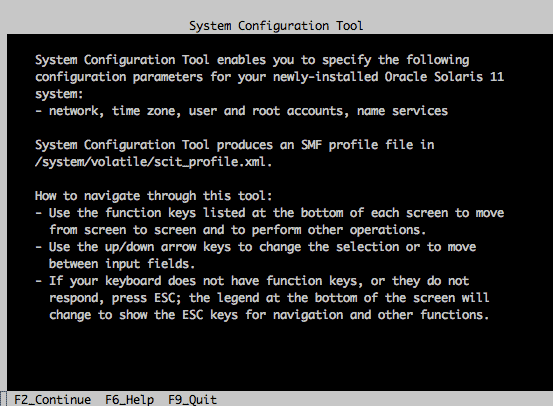
Set the hostname for the zone as zone01 and mode of network configuration as manual.
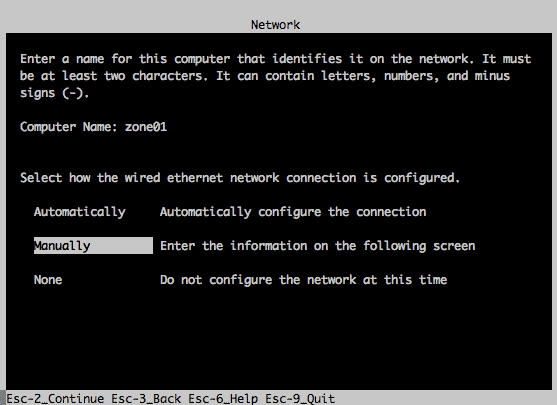
On the next screen give the IP address to the NIC card net0 and a netmask.
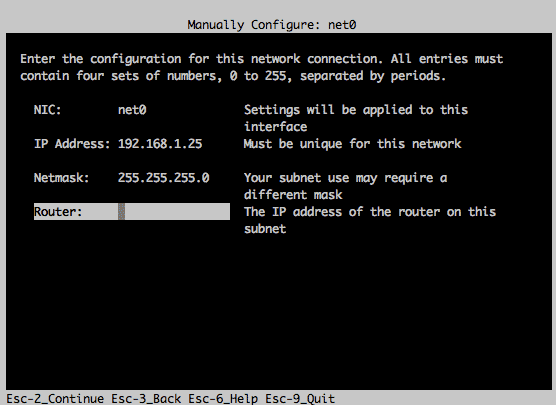
We will not configure any DNS service so select “Do not configure DNS”.
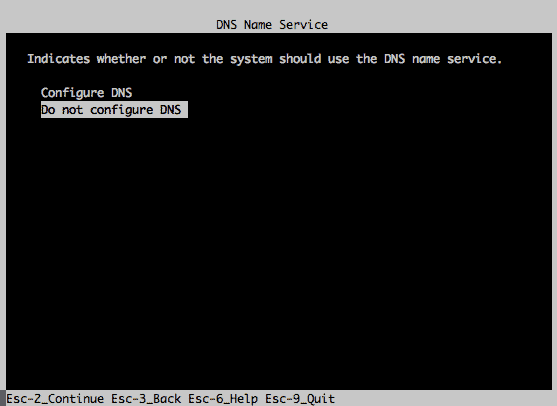
Select “None” option for alternate name service.
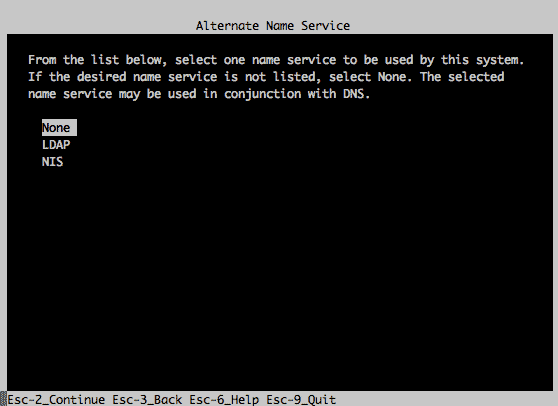
On the next screens set the time zone according to your location.
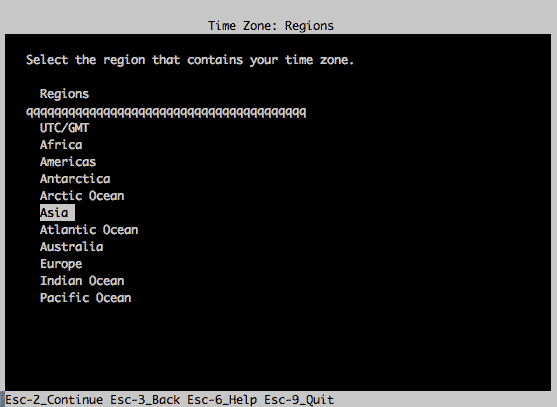
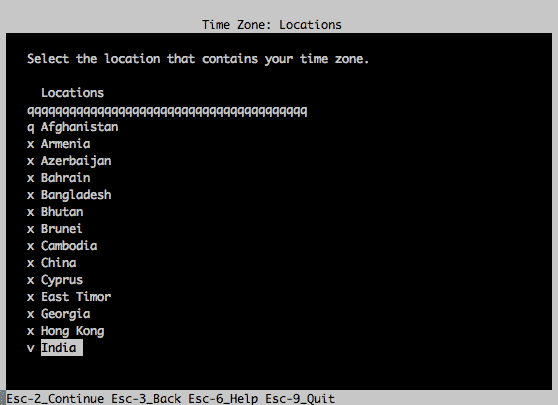
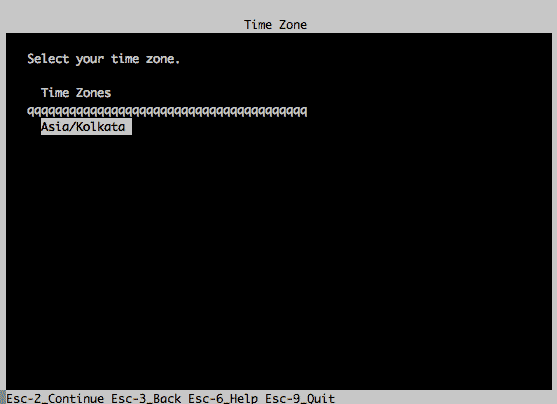
Now set the root password. Also if you want any user to be created, you can do it on this screen.
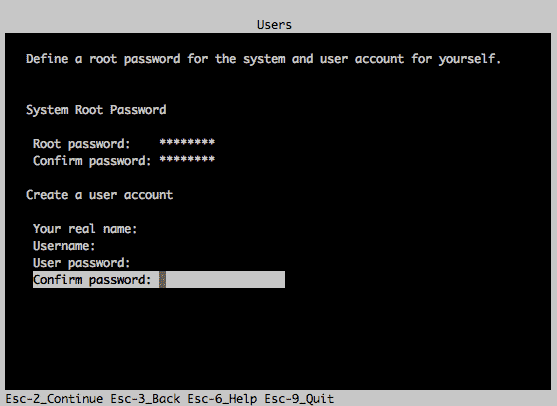
Double check the system configuration summary before going forward.
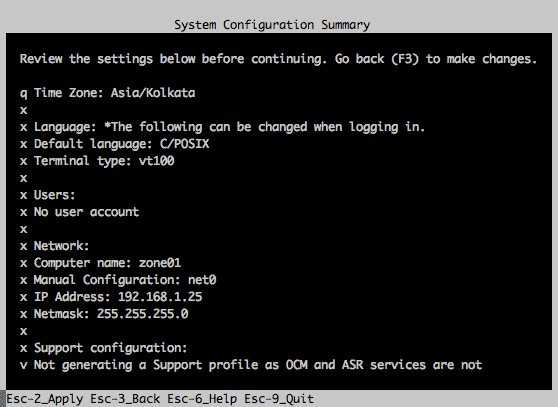
After this the system will get configured. No need to login as its the console login of the zone. Use “~.” to come out of the console.
Check the status of the zone01 from the global zone. It should be running now.
Check the status of the zone01 from the global zone. It should be running now.
root@geeklab:~# zoneadm list -icv
ID NAME STATUS PATH BRAND IP
0 global running / solaris shared
1 zone01 running /rpool/zone01 solaris excl
If you check dladm, you would see a virtual NIC created :
root@geeklab:~# dladm show-link LINK CLASS MTU STATE OVER net0 phys 1500 up -- zone01/net0 vnic 1500 up net0
Now login to the zone
root@geeklab:~# zlogin zone01 [Connected to zone 'zone01' pts/3] Oracle Corporation SunOS 5.11 11.1 September 2012 root@zone01:~# uname -a SunOS zone01 5.11 11.1 i86pc i386 i86pc
Check the network settings :
root@zone01:~# dladm show-link LINK CLASS MTU STATE OVER net0 vnic 1500 up ?
root@zone01:~# ipadm show-addr ADDROBJ TYPE STATE ADDR lo0/v4 static ok 127.0.0.1/8 net0/v4 static ok 192.168.1.25/24 lo0/v6 static ok ::1/128 net0/v6 addrconf ok fe80::8:20ff:fe89:4b7c/10
root@zone01:~# ifconfig -a
lo0: flags=2001000849[UP,LOOPBACK,RUNNING,MULTICAST,IPv4,VIRTUAL] mtu 8232 index 1
inet 127.0.0.1 netmask ff000000
net0: flags=1000843[UP,BROADCAST,RUNNING,MULTICAST,IPv4] mtu 1500 index 2
inet 192.168.1.25 netmask ffffff00 broadcast 192.168.1.255
ether 2:8:20:89:4b:7c
lo0: flags=2002000849[UP,LOOPBACK,RUNNING,MULTICAST,IPv6,VIRTUAL] mtu 8252 index 1
inet6 ::1/128
net0: flags=20002004841[UP,RUNNING,MULTICAST,DHCP,IPv6] mtu 1500 index 2
inet6 fe80::8:20ff:fe89:4b7c/10
ether 2:8:20:89:4b:7c
If you check zfs list, you would only see zfs dataset assigned to zone and not the global file system.
root@zone01:~# zfs list NAME USED AVAIL REFER MOUNTPOINT rpool 441M 4.48G 31K /rpool rpool/ROOT 441M 4.48G 31K legacy rpool/ROOT/solaris 441M 4.48G 416M / rpool/ROOT/solaris/var 24.4M 4.48G 23.8M /var rpool/VARSHARE 39K 4.48G 39K /var/share rpool/export 63K 4.48G 32K /export rpool/export/home 31K 4.48G 31K /export/home
To check the complete configuration details of the zone from non-global zone :
root@geeklab:~# zonecfg -z zone01 info zonename: zone01 zonepath: /rpool/zone01 brand: solaris autoboot: true bootargs: -m verbose file-mac-profile: pool: limitpriv: scheduling-class: ip-type: exclusive hostid: fs-allowed: anet: linkname: net0 lower-link: auto allowed-address not specified configure-allowed-address: true defrouter not specified allowed-dhcp-cids not specified link-protection: mac-nospoof mac-address: random auto-mac-address: 2:8:20:89:4b:7c mac-prefix not specified mac-slot not specified vlan-id not specified priority not specified rxrings not specified txrings not specified mtu not specified maxbw not specified rxfanout not specified vsi-typeid not specified vsi-vers not specified vsi-mgrid not specified etsbw-lcl not specified cos not specified pkey not specified linkmode not specified

No comments:
Post a Comment